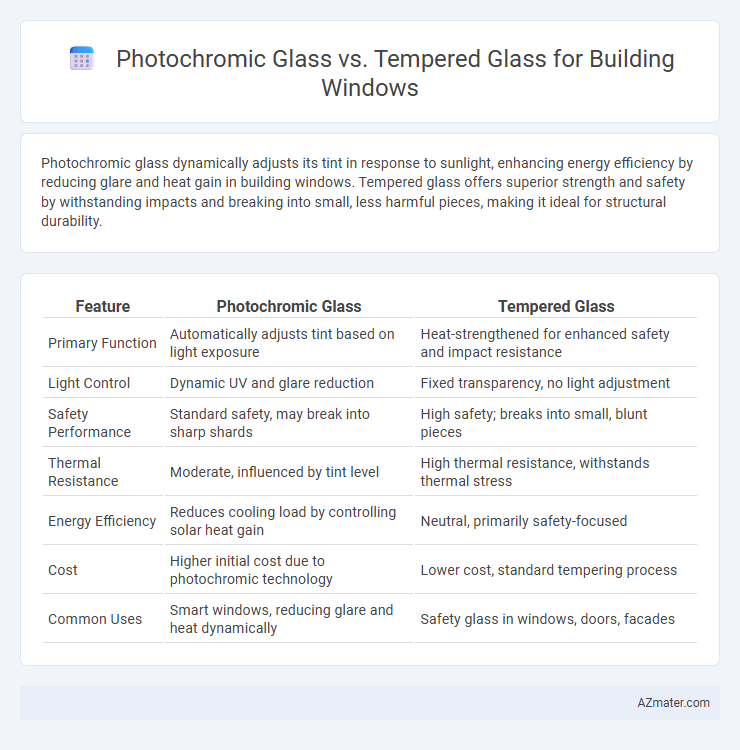Photochromic glass dynamically adjusts its tint in response to sunlight, enhancing energy efficiency by reducing glare and heat gain in building windows. Tempered glass offers superior strength and safety by withstanding impacts and breaking into small, less harmful pieces, making it ideal for structural durability.
Table of Comparison
| Feature | Photochromic Glass | Tempered Glass |
|---|---|---|
| Primary Function | Automatically adjusts tint based on light exposure | Heat-strengthened for enhanced safety and impact resistance |
| Light Control | Dynamic UV and glare reduction | Fixed transparency, no light adjustment |
| Safety Performance | Standard safety, may break into sharp shards | High safety; breaks into small, blunt pieces |
| Thermal Resistance | Moderate, influenced by tint level | High thermal resistance, withstands thermal stress |
| Energy Efficiency | Reduces cooling load by controlling solar heat gain | Neutral, primarily safety-focused |
| Cost | Higher initial cost due to photochromic technology | Lower cost, standard tempering process |
| Common Uses | Smart windows, reducing glare and heat dynamically | Safety glass in windows, doors, facades |
Introduction to Photochromic and Tempered Glass
Photochromic glass automatically adjusts its tint based on sunlight exposure, reducing glare and enhancing energy efficiency in building windows. Tempered glass undergoes a heat treatment process to increase strength and safety by shattering into small, blunt pieces when broken. Choosing between photochromic and tempered glass depends on specific requirements for light control, durability, and safety in architectural applications.
How Photochromic Glass Works
Photochromic glass contains light-sensitive molecules that react to ultraviolet (UV) radiation, causing the glass to automatically darken when exposed to sunlight and lighten in low-light conditions. This dynamic tinting enhances energy efficiency by reducing heat gain and glare without compromising natural light or views. Unlike tempered glass, which provides structural strength and safety through heat treatment but maintains a fixed transparency, photochromic glass offers adaptive solar control that improves occupant comfort and reduces cooling costs.
Tempered Glass: Features and Benefits
Tempered glass offers exceptional strength and safety for building windows, being up to five times stronger than regular glass and designed to shatter into small, blunt pieces upon impact. Its thermal resistance allows it to withstand extreme temperature changes without cracking, making it ideal for various environmental conditions. This durability, combined with enhanced security features and improved energy efficiency, makes tempered glass a superior choice for modern architectural applications.
Key Differences Between Photochromic and Tempered Glass
Photochromic glass automatically adjusts its tint in response to sunlight, providing energy efficiency and glare reduction by darkening when exposed to UV rays, while tempered glass is heat-treated for enhanced strength and safety but does not change transparency. Photochromic glass offers dynamic light control and UV protection, ideal for comfort and energy savings in building windows, whereas tempered glass is valued for its durability and shatter-resistant properties, ensuring safety during impact or breakage. The key distinction lies in photochromic glass's adaptive light modulation compared to tempered glass's mechanical toughness and breakage behavior.
Light Control and Energy Efficiency Comparison
Photochromic glass dynamically adjusts tint in response to sunlight, reducing glare and controlling solar heat gain, which enhances indoor comfort and lowers cooling costs. Tempered glass offers high strength and safety but lacks adaptive light control, relying instead on external shading or coatings for energy efficiency. Photochromic glass provides superior energy savings by minimizing reliance on artificial lighting and HVAC systems, making it more effective for sustainable building designs.
Durability and Safety Aspects
Photochromic glass offers enhanced durability by adapting to changing light conditions, reducing UV radiation and heat penetration, which helps preserve interior furnishings and structural materials. Tempered glass excels in safety due to its high impact resistance and tendency to shatter into small, blunt pieces rather than sharp shards, minimizing injury risks. Both materials provide critical benefits in building windows, with photochromic glass emphasizing adaptive protection and tempered glass prioritizing structural strength and occupant safety.
Aesthetic and Design Flexibility
Photochromic glass offers dynamic shading by automatically adjusting tint based on sunlight intensity, enhancing aesthetic appeal with seamless integration into modern facades. Tempered glass provides a sleek, uniform appearance with high strength and safety, allowing for large, uninterrupted window panes that support minimalist design trends. Combining photochromic functionality with tempered glass enhances design flexibility, ensuring both safety and adaptive light control in building applications.
Installation and Maintenance Requirements
Photochromic glass requires careful handling during installation to avoid damage to its light-sensitive coating, often necessitating professional services familiar with its specialized properties. Tempered glass offers easier installation due to its durability and resistance to breakage, making it less prone to damage during handling or fitting. Maintenance for photochromic glass involves cleaning with non-abrasive materials to preserve the photochromic layer, whereas tempered glass maintenance focuses primarily on routine cleaning without special precautions.
Cost Analysis of Photochromic vs Tempered Glass
Photochromic glass typically incurs higher initial costs than tempered glass due to its advanced light-adaptive technology and specialized manufacturing processes. Tempered glass offers a more cost-effective solution for building windows, with lower material and production expenses while providing essential safety and strength features. Over time, photochromic glass can yield energy savings by reducing cooling and lighting costs, potentially offsetting its upfront price difference compared to traditional tempered glass.
Choosing the Right Glass for Your Building Windows
Photochromic glass adjusts its tint based on sunlight intensity, reducing glare and controlling indoor temperature, making it energy-efficient for building windows. Tempered glass offers superior strength and safety by resisting impact and shattering into small, blunt pieces, ideal for high-traffic or security-sensitive areas. Choosing the right glass depends on balancing energy savings and durability needs; photochromic glass excels in light management, while tempered glass ensures structural safety and impact resistance.

Infographic: Photochromic glass vs Tempered glass for Building window
 azmater.com
azmater.com